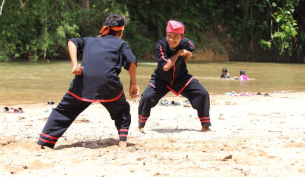ARTS AND CULTURE INFORMATION GATEWAY
Immerse yourself in the colorful world of art and culture! From traditional heritage to contemporary works, discover uniqueness that reflects the nation's identity and identity
SILAT KURA-KURA
Picture
1
Video
No record
Today's Visitor
7
Number of Visitors
413
Introduction and history
Silat Kura-Kura is a traditional martial art originating from Kuala Berang, Hulu Terengganu, which emerged in the 19th century. This art was founded by a martial arts master who was inspired by a fight between two turtles he observed while meditating in a cave at Hulu Paka. The unique movements of the turtles, such as defending themselves and strategically attacking, were adapted into the techniques of this martial art. Tok Ibrahim Hussin, the main founder, passed this knowledge on to his student Yunus Mamat, who later promoted the art in Kampung Menerong, Kuala Berang.
Training for Silat Kura-Kura is typically conducted in sandy areas such as riverbanks, which resemble the natural habitat of turtles. A prominent figure like Mohamad Razali bin Ismail has played a significant role in disseminating this art to this day, with his students located outside Terengganu, including in Johor, Kelantan, and Singapore. Silat Kura-Kura has been showcased in major events, such as cultural performances in Singapore and during the visit of Tun Dr. Mahathir Mohamad to Hulu Terengganu.
However, Silat Kura-Kura faces challenges in maintaining its legacy. The lack of skilled instructors, competition from modern martial arts like Pencak Silat, and limited exposure through media and competition platforms have caused this art to be increasingly forgotten. Younger generations are more inclined toward modern activities that are easier to learn and more dynamic. To ensure its continuity, several preservation measures need to be undertaken. These include organizing workshops and classes for young generations, documenting the history and techniques of Silat Kura-Kura through films and books, and promoting it through social media and cultural events. Collaboration between the government, private sectors, and educational institutions is also crucial to incorporating elements of Silat Kura-Kura into the arts and culture curriculum. Through these efforts, Silat Kura-Kura can be preserved and passed down to future generations, thereby strengthening the cultural identity of the Malays on a global stage.
Primarily, Silat Kura-Kura functions as a martial art for self-defense, but it has also evolved into a traditional form of entertainment at various events such as weddings and receptions for dignitaries. This art plays a vital role in preserving the Malay cultural heritage and has the potential to become a cultural tourism attraction at both local and international levels. Performances are often accompanied by traditional musical instruments such as the gong, flute, and drums, and sometimes involve the use of weapons like staffs or machetes. The movements in Silat Kura-Kura mimic the style of turtles, incorporating defensive maneuvers while tactically attacking, making it both unique and captivating. However, this art is also imbued with traditional customs and taboos, including respect for natural spirits such as the spirits of water and sand.
-
The performance of Silat Kura-Kura is usually conducted in sandy areas, such as riverbanks, which resemble the turtles’ natural habitat and reflect the essence of this art.
Performances involve movements that mimic the style of turtles, featuring slow steps, defensive techniques, and strategic attacks. The choreography often delights audiences with the antics of the practitioners that imitate turtle movements. Performances are accompanied by traditional musical instruments such as the gong, flute, and drums, which play a significant role in creating an immersive aesthetic atmosphere.
Silat Kura-Kura is frequently performed at events such as weddings, receptions for dignitaries, and cultural celebrations, making it a key attraction at such gatherings. The performance can be carried out individually or in groups, depending on the needs of the event. Additionally, certain customs and taboos are observed before the performance, such as paying homage to natural spirits believed to provide strength to the practitioners. The combination of traditional elements, aesthetics, and techniques makes the performance of Silat Kura-Kura unique and rich in cultural value.
Reference Source
Bahan Bacaan
Asikin, M. (1997). Silat Nusantara: Warisan Budaya Bangsa. Jakarta: Pustaka Indonesia.
Donn F. Draeger. (1972). The Weapons and Fighting Arts of Indonesia. Tokyo: Kodansha International.
Mahmud, I. (2005). Perkembangan Silat Tradisional dalam Kebudayaan Nusantara. Jurnal Kebudayaan Indonesia, 12(3), 45-58.
Artikel ini membahas berbagai teknik silat yang terinspirasi oleh binatang, termasuk filosofi gerakan yang terkait dengan alam.
Rahmawati, D. A. (2018). Peran Filosofi dalam Seni Bela Diri Tradisional Indonesia. Jurnal Seni Budaya Nusantara, 8(2), 102-114.
Tokoh (jika ada temu bual tokoh)
Location
State JKKN Contact Information
Encik Azaha Othman
Cultural Officer
Jabatan Kebudayaan dan Kesenian Negara Terengganu
Kompleks JKKN Terengganu
Kuala Ibai,
20400, Kuala Terengganu,
TERENGGANU DARUL IMAN
09-617 8831










